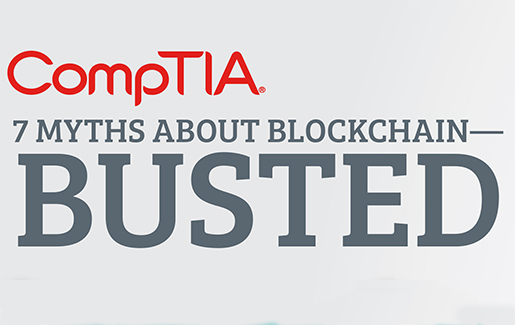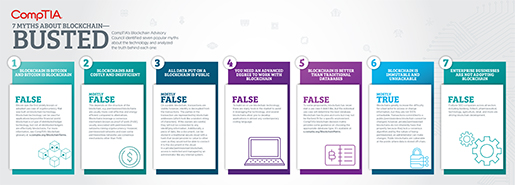
The dictionary defines blockchain as “a digital database containing information (such as records or financial transactions) that can be simultaneously used and shared within a large decentralized, publicly accessible network.” But that’s just scratching the surface.
Every day, tech companies and businesses find seemingly new use cases for blockchain, creating almost limitless ways that the technology can be leveraged to solve business problems. And while Bitcoin and other cryptocurrencies are perhaps the most popular example of what blockchain can do, they are also the root of many myths and misconceptions around the technology according to Neeraj Satija, CEO and CTO of Concordus Applications and chair of CompTIA’s Blockchain Industry Advisory Council.
In order to help customers better understand what blockchain can do, as well as increase awareness of its potential, the council recently developed an infographic looking to dispel some of the myths.
“Blockchain got a lot of publicity because of Bitcoin, but it also attracted a lot of regulatory and anti-money laundering attention too. So, success reflected on blockchain, but so did the controversies,” Satija said. “Blockchain, the technology, got a raw deal. We want to show people the truth with this infographic.”
Increased Awareness Brings Higher Demand
Blockchain is such a disruptive, unique technology—very different from conventional databases and web architecture—that many people don’t fully understand what it is and what it can do, according to Satija.
“Not many people have grasped the intricacies and power of this technology. You can’t look at blockchain from the same lens as traditional technology,” Satija said. “Blockchain allows you to build trust between two peers trading with each other, in any currency, in any part of the globe, without the need of having a third party like a bank or broker.”
The council decided to create an infographic that would tackle popular myths and do it in a way that non-technical people could understand and then hopefully want to know more about blockchain.
“If you are a new company to blockchain and like most people you have some misperceptions, you can go through the myth busters infographic and then visit CompTIA’s blockchain resource hub and see more relevant content. For example, the decision matrix, which walks you through some questions that you need to know if blockchain the right technology for you,” Satija said. “The myth busters infographic was meant to connect to other content and additional progressions that can handhold someone and walk them through the journey.”
The busted myths infographic will continue to evolve as blockchain is embraced by more industries and new misperceptions arise, Satija said. “You don’t buy blockchain technology, you buy a solution that leverages blockchain and solves a business problem,” he said.

Market Expansion, Growing Opportunity
Blockchain technology spending is expected to reach $4.3 billion this year, nearly 58% more compared to 2019, according to IDC. Even factoring in the impact of COVID-19, IDC still expects 57% compounded annual growth in blockchain spending through 2023.
“A lot of industries have started doing some amazing work with blockchain, like the supply chain industry or the e-government segment,” Satija said. “It’s not just embraced by private organizations and companies that deal with technology, but by state and national governments across the world. I see a massive upsurge of people wanting to learn blockchain—and implement it. The most heartening thing for me is it’s being embraced by verticals that had not even thought about it previously.”
With so much activity—and innovation—in motion, now’s the time for CompTIA members to embrace blockchain and explore how it can used to benefit their own businesses.
“That goes for small businesses too,” Satija said. “People are beginning to realize blockchain can be used as an enabling technology as well—it’s enabling innovative use cases that incorporate IoT, AI, drones, and much more. It’s here to stay, it’s growing across industries and verticals, it’s enabling a lot of disruption, and we want everyone to know that.”

 Add CompTIA to your favorite RSS reader
Add CompTIA to your favorite RSS reader

